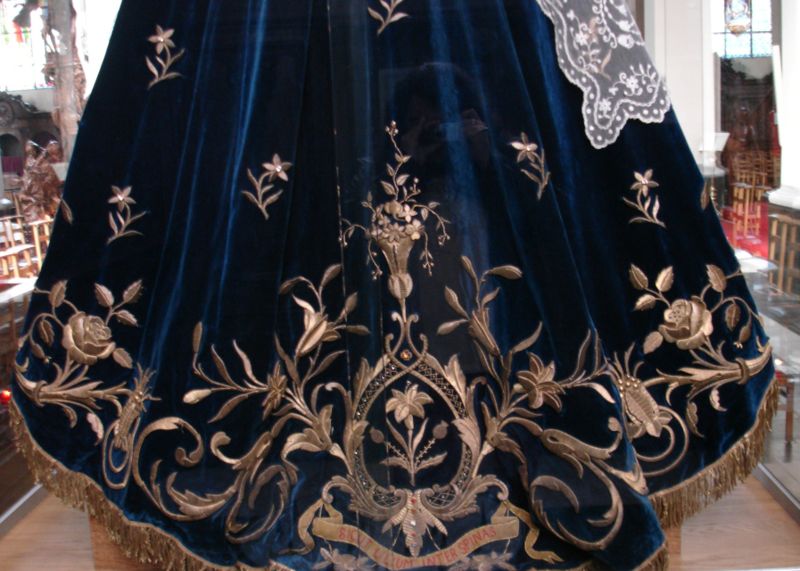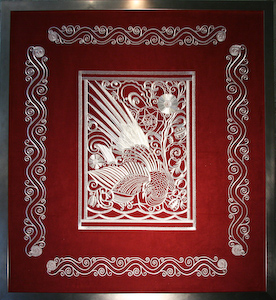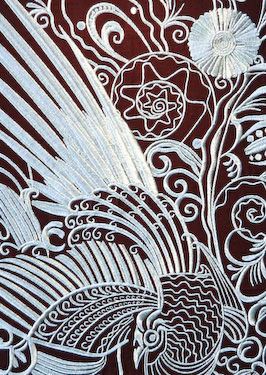Some embroidery items are more breathtaking than others. I don’t remember where or when I got this photo, and with apologies to the owner of this photo, I present to you a little something you can whip out in a few hours.
This might be a wonderful sumptuous table topper; whatever it is, it has a grandeur all its own. The second photo is Courtesy of Robert Young, and has an amazing 281,000 metallic stitches. It certainly is one impressive piece of artwork.




This blog will not be a comprehensive metallic thread discussion because I have not been able to try so many of the metallics on the market. In addition, new thread comes out so often that it is difficult to keep up with them. I am only going to discuss some of my observations, readings and personal experiences.
I think that there are several things in the metallic world that we might agree upon. Some of them are:
- Always use a new metallic needle. These needles are made specifically for metallic thread and have a larger eye than standard needles. Some might have a coating and/or a shaft to help move the thread. They are a little more expensive than embroidery needles, but well worth the few extra cents.
- I usually only use metallics in very small amounts such as an accent color in a pattern. For instance, I did a Minnie Mouse once and used the metallic on just her hair bow. That probably did not use up more than 3 yards of thread, making it less problematic.
- I normally will watch the thread very carefully as it comes off the spool. In my current project, I had the gold thread nesting under the fabric. It was spinning wildly and that told me there was a problem I could not see on top of the design. Underneath was a big mess and I had to carefully remove the nested threads and restart, not a fun thing to do.
- Slow down your machine’s speed. I did my metallic part of the design at 350 stitches per minute (spm) which was really slow! But, when the metallic was done, I returned to the sewing speed of 800 spm. It changed the overall time for the design from 25 minutes to about 35 minutes and I can live with that.
- Avoid designs that are really dense or have over lapping stitches. Any friction can be a problem for the metallic thread. If there are very small stitches, that could be detrimental to your project as well. Some designs may be marked for metallic thread in the color chart and that indicates that the digitizer made adjustments for any areas that include metallic thread.
- Make sure you have enough time to do this particular feature in your embroidery. If you are under a deadline, it is probably not the time to experiment with metallics. You need time to work with it and patience to get to the end of your project.
I have read so many other bits of information but these don’t make a great deal of sense to me personally. I don’t mean to say they are wrong, but I have given my reason for discarding them as viable rules for metallics:
- Watch your tension. Many ME’ers feel that the tension should be reduced. When I had the nesting problems, I actually had to increase the tension for better results. You need to test your machine, thread and design to see what will work best. Don’t assume that any of the rules are carved in granite.
- Freeze the thread. This one has confused me from the first moment I read it. How would freezing metal help? It seems to me that freezing it, even for a short time, would cause the thread to be less flexible and possibly brittle. If this one works for you, great. I personally think it is illogical.
- Another idea that I have heard was to run the thread through a ‘packing peanut.’ That one was curious to me because it had no rationale as to why the peanut would help. Perhaps there is some logic there, but I am unable to see it. If you try this, let us all know about the outcome.
- Use a special thread stand. I have a theory about thread stands – if the engineers who designed this fantastic machine thought it needed a stand, it would have placed a little stick of plastic in the box. How expensive could that stick be?? They would have had a place to put that stick on the machine, possibly on the side not too near the wheel. The engineers did not do that, and they went to school for a long time to be called engineers. Do I have a thread stand? Yes, the store convinced me that I needed it and so I paid my money. I use it now for a paper weight for my notes I have near my machine, so, yes, I do use it.
- Put the thread in a container behind the machine. Huh? See previous information.
The bottom line is, use it if you feel it has value. This information is just my humble opinion. I may be wrong, I remember being wrong once before (rolling on floor, laughing to the point of tears).
I did find a few interesting things during my project. These made sense to me and I have explained why they seemed prudent:
- I used water soluble stabilizer (wss) for the backing. I did this because cut-away stabilizers are too structured and rigid. I feel tear away stabilizers did not have enough stability for the metallic thread. I did feel that the wss has ‘give’ with stability. I did not wash it, but I did cut most of it away. I felt it has the best of both worlds. As you may be aware, I do use Badgemaster most of the time.
- My fabric was soft rayon and I felt that its properties were very right for metallic thread. I prefer soft and natural varieties of fibers for all my projects. An unyielding fabric may present problems that rayon does not. However, when time permits, I will be trying to work with other fabrics and metallics to see the issues and results. As previously noted, I don’t think any rule is carved in stone. Give other fibers a try and let me know about how it goes for you.
- I did reduce my percentage of stitches by 5%. I felt that would not interfere with the density and avoid any stitches that were too close or stitched from the same spot. Since my very first two colors were metallic, I was able to stop sewing after the metallic, cancel the design, reset the design (putting it back to 100%) and go to thread color number 3.
- I have been experimenting with some metallics and have found some to be badly lacking in quality, sheen or usability. I did use Coats and Clark in the copper color and Sulky in the gold color. I found both of them to have a real metallic quality, excellent sheen and very easy to work with. One thing that I liked about them was that they were both were much like a strand of colored aluminum which is how I feel metallics should be. Some metallics are fabric with some metal thrown into the mix and those just don’t deliver in my opinion.
- Did I have breakage with both threads? Yes, I did. But I did make this observation and test: The copper (first thread) worked smoothly for the first 1,300 stitches. The distance was approximately 5,000 stitches, and after that first success, the thread started breaking about every 600, or less, stitches. The same thing happened with the gold (second thread). There were about 2,100 stitches and the first about 1,000 stitches were just fine. Well, I got to thinking about that and saw a possible hint in those numbers. I considered that the top most thread on the spools was uncompressed by a layer above them. I took the gold thread and spread a line of it across my room twice. I let it relax for about 30 minutes. I gently rewound the spool and when I went to sew with it – success, no more breaks.
Do I think I found the best method to keep metallics from breaking? I don’t know. I do know it seemed to be reasonable to let it rest. Please let me know if you try this and your own outcome. This may just be another method in the arsenal of tips for machine embroidery.
Here is my humble piece of metallic. There were over 7,000 stitches for the metallic thread and I am pleased with the outcome.
